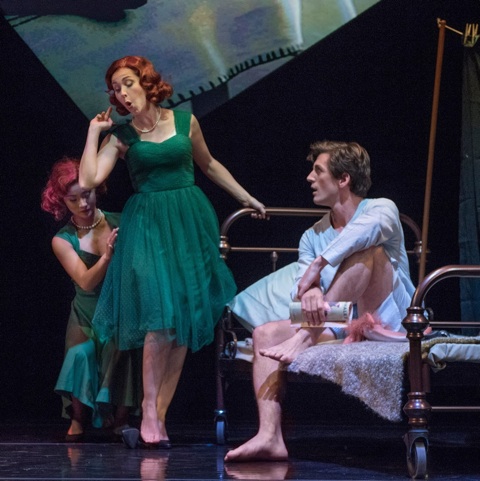A compelling descent.
Last Friday, May 26, Opera Parallèle explored the complex relationship between a brother and sister for a sold-out crowd at the San Francisco Conservatory of Music. Philip Glass’ opera, Les Enfants Terribles, was one long downward spiral of symbolism and obsession based on the poetry of Jean Cocteau and impelled by three pianos pounding away at a minimalist score.
Cocteau wrote his story of destructive love in the aftermath of World War 1, a war whose shadow erased the Romantic era and engendered a deep questioning into the roots of violence. In his 1929 book Cocteau created a surreal potboiler where life merges with fantasy. It was as surreal as his transcendently tragic film, Orpheus, but more claustrophobic. Instead of his characters entering the realm of Death through the portals of mirrors, in Les Enfants Terribles his protagonists help each other to escape life into a private fantasy world.
Paul and Lise begin as innocent brother and sister, playful and competitive, but then threads of jealousy, sexuality, and power turned their “play” more sinister.
While family is meant to be the nurture from which we learn to love ourselves and each other, the obverse is also true: the unmet needs, small hatreds and competitions of these two siblings build throughout the opera into a shocking ending. Glass’ music was the vehicle that transported that tension into the realm of dreams, with the three pianos creating a wealth of mono-tonal shadings to sketch a sere landscape.
 Opera Parallèle is far and away the Bay Area’s most fiercely creative company, and director Brian Stauffenbiel conceived this endeavor as a story that could be told on many levels. After the lights came down, conductor Nicole Paiement stood to conduct the three pianos (a necessity for their complex weave), but did not raise her baton for long minutes while snow “fell” through three screens and a scrim across the stage. That silence stretched almost uncomfortably, pushing us to feel the cold, silent loneliness of this world.
Opera Parallèle is far and away the Bay Area’s most fiercely creative company, and director Brian Stauffenbiel conceived this endeavor as a story that could be told on many levels. After the lights came down, conductor Nicole Paiement stood to conduct the three pianos (a necessity for their complex weave), but did not raise her baton for long minutes while snow “fell” through three screens and a scrim across the stage. That silence stretched almost uncomfortably, pushing us to feel the cold, silent loneliness of this world.
Then the pianos exploded into high eighth notes and sharp dissonances, and two dancers leaped onto the stage. Their movements were classical lifts and modern spirals that engaged and defined and rejected. A narrator described the back-story, of young adults and their “overlapping pools of truth and fantasy,” and one realized that the choreography also reflected those overlapping pools.
Two beds were rolled onstage, props that rotated and moved silently across the stage throughout the production, a set built for dreaming.
Bass-baritone Hadleigh Adams played Paul to the hilt, listless and self-absorbed, petty and pretty, but with a voice that was an instrument of pure opera: immediate and arrestingly resonant. Opposite him soprano Rachel Schutz brought Lise into focus with acrobatic high notes and mercurial moods.
And around them flowed the two dancers, Brett Conway and Steffi Cheong. Each dressed as one of the siblings, creating conflicted feelings from their wordless vocabulary – the sharp weighting of a line, a collapsing shift of balance. They comforted and crabbed and curled themselves into the beds. That choreography, finely conceived throughout by Amy Siewert, felt like it could expand or contract on a dime and small motions could amplify into something that changed the whole, or turn suddenly vicious.
Two more characters filled out the story and vocal landscape: the richly hued mezzo-soprano Kindra Scharich and tenor Andres Ramirez, who also narrated. Adding to the insular narcissism, each character was in love with one of the siblings.
Stauffenbiel’s multi-layered approach was effective. In the somnambulism scene, Lise sings, “Sometimes Paul walks in his sleep.” The pianos traded upward gestures, short scales on an endless stairway of dreamy oxygenation. The dancers reprised that, with Cheong leading Conway in languid pulls and pushes. And while the singers lay in their parallel beds, Paul’s face loomed large on the screens, eyes rolled up as he wandered the rooms of a house adorned with cryptic sculptures. That film within the opera added a disconcerting immersion into a fantasy life that was almost suffocating.
As the opera devolved into its grisly consummation, there was a sense of inevitability, of human failure winning out over love. And driving that action with sparkle and desperation were three of the Bay Area’s top pianists: Keisuke Nakagoshi and Eva-Maria Zimmerman (and those two are also ZOFO, a nationally touring four-hands duo), along with Kevin Korth.
So why would anyone go to such a depressing opera, even such a work of thoughtful beauty? A related question is why do we watch a train wreck? In this case it’s because we are all on this train.
—Adam Broner
Photo above, l to r: dancer Steffi Cheong, soprano Rachel Schutz, and bass Hadleigh Adams; photo by Steve DiBartolomeo
